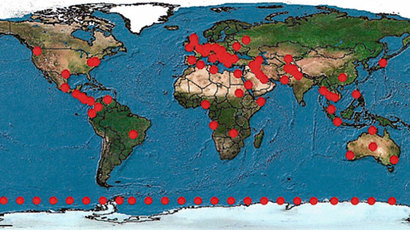IRS gets help from DEA and NSA to collect data

The Internal Revenue Service reportedly received incriminating information on US citizens from the Drug Enforcement Agency, with the assistance of the National Security Agency, before concealing the paper trail from defendants.
Details of a Drug Enforcement Administration (DEA) program that
provides tips to the Internal Revenue Service (IRS) and then
advises them to “recreate the investigative trail” were
published in a manual used by IRS agents for two years, Reuters
revealed.
The practice of concealing the source of information has attracted the scrutiny of legal experts and is now
under review by the US Justice Department.
A brief entry in the Internal Revenue Manual instructed agents of
the US tax agency to omit any reference to information provided
by the DEA's Special Operations Division, especially with regard
to “affidavits, court proceedings or investigative files.”
The entry was published and posted online in 2005 and 2006, and
removed in early 2007. An IRS spokesman had no comment on
the entry or on why it was removed from the manual, Reuters
reported.
The IRS publication provides some further detail on the parallel
construction concept.
"Special Operations Division has the ability to collect,
collate, analyze, evaluate, and disseminate information and
intelligence derived from worldwide multi-agency sources,
including classified projects," the IRS manual says. "SOD
converts extremely sensitive information into usable leads and
tips which are then passed to the field offices for real-time
enforcement activity against major international drug trafficking
organizations."
According to the document, IRS agents are directed to use the
intelligence as a starting point for unearthing new,
"independent" evidence: "Usable information regarding
these leads must be developed from such independent sources as
investigative files, subscriber and toll requests, physical
surveillance, wire intercepts, and confidential source
information. Information obtained from SOD in response to a
search or query request cannot be used directly in any
investigation (i.e. cannot be used in affidavits, court
proceedings or maintained in investigative files)."

In addition to the IRS, the Special Operations Division
cooperates with a number of government agencies, including the
Federal Bureau of Investigation, the National Security Agency and
the Central Intelligence Agency.
The way the intelligence-gathering system worked is as follows:
The Special Operations Division of the DEA channels secret data
from overseas NSA intercepts, domestic wiretaps, informants and a
large DEA database of telephone records to authorities nationwide
to assist them with criminal investigations of US citizens,
according to the Reuters report.
The DEA telephone database is different from the NSA database
that was revealed by former NSA contractor Edward Snowden, who is
now living in Russia under asylum.
The DEA, which works behind the scenes to investigate drug
dealers, money launderers and other criminals, argues that the
practice does not violate the law and has been in “near-daily
use since the 1990s.” The agency said the reason it directs
federal agents to recreate the investigation trail is to
“protect sources and methods, not to withhold evidence.”
Judicial hurdles ahead
Legal experts, however, say that concealing potential evidence
from defendants violates the US Constitution. According to
documents and interviews obtained by Reuters, federal agents use
a procedure called "parallel construction" to conceal the
tracks of the investigative trail. For example, agents could say
that an investigation was launched due to a traffic violation as
opposed to an SOD tip.
House Intelligence Committee Chairman Mike Rogers expressed
concern with the parallel construction program.
"If they're recreating a trail, that's wrong and we're going
to have to do something about it," Rogers, a former FBI
agent, said on the Mike Huckabee Show radio program. "We're
working with the DEA and intelligence organizations to try to
find out exactly what that story is."
Spokespeople for the DEA and the Department of Justice declined
to comment.
Sen. Rand Paul, a member of the Homeland Security and Government
Affairs Committee, said he was troubled that DEA agents have been
"trying to cover up a program that investigates
Americans."
"If the Constitution still has any sway, a government that is
constantly overreaching on security while completely neglecting
liberty is in grave violation of our founding doctrine," Paul
added
The NSA database contains data about every telephone call made
inside of the United States. This information, according to a NSA
official, as quoted by Reuters, “is not used for domestic
criminal law enforcement.”
The DEA database, or DICE for short, consists largely of phone
log and internet data gathered legally by the DEA through
“subpoenas, arrests and search warrants nationwide.” DICE
has on file “about 1 billion records,” which are stored
for about one year before being destroyed, DEA officials
said.














